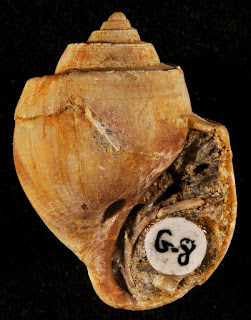

Tejonia moragai is small to medium-size. The above picture on the left is the front or apertural view of an adult specimen (30.7 mm height, 22.6 mm diameter). The picture on the above right is the abapertural or back view of the same specimen.
This gastropod is characterized by having an inflated last whorl that is smoothish but with minute spiral sculpture, a somewhat moderately elevated spire with tabulate (squared-off and indented) whorls, a distinct umbilical pit, and an absence of an umbilical callus.
If you look at my previous post, which concerns the Eocene Pachycrommium clarki, you will see that T. moragai resembles P. clarki. There are a few subtle differences, thus, in my opinion, the two gastropods are different species. Tejonia moragai is smaller in size, has minute-spiral sculpture (lines), an umbilical pit rather than a slit, and no umbilical callus. The sculpture, however, could easily be worn or weathered away, thereby making the distinction between these two species difficult. The main question, however, is whether they belong to the same genus? An answer requires a detailed comparative study, which has so far, been wanting.

No comments:
Post a Comment